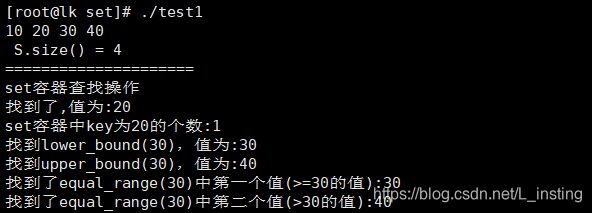STL常用容器(7)--set/multiset容器
STL常用容器--set/multiset容器
- 1 set/multiset容器基本概念
-
- 1.1 set容器基本概念
- 1.2 multiset容器基本概念
- 2 set常用API
-
- 2.1 set构造函数
- 2.2 set赋值操作
- 2.3 set大小操作
- 2.4 set插入和删除操作
- 2.5 set查找操作
- 3 对组(pair)
- 4 案例
-
- 4.1 内置数据类型
- 4.2 使用对组pair判断set容器是否插入成功
- 4.3 自定义数据类型
-
- 4.3.1 指定排序规则
- 4.3.2 将自定义数据类型通过位域组成内置数据类型
1 set/multiset容器基本概念
1.1 set容器基本概念
set的特性是。所有元素都会根据元素的键值自动被排序。
set的元素不像map那样可以同时拥有实值和键值,set的元素即是键值又是实值。set不允许两个元素有相同的键值。
我们可以通过set的迭代器改变set元素的值吗?不行,因为set元素值就是其键值,关系到set元素的排序规则。如果任意改变set元素值,会严重破坏set组织。换句话说,set的iterator是一种const_iterator.
set拥有和list某些相同的性质,当对容器中的元素进行插入操作或者删除操作的时候,操作之前所有的迭代器,在操作完成之后依然有效,被删除的那个元素的迭代器必然是一个例外。
1.2 multiset容器基本概念
multiset特性及用法和set完全相同,唯一的差别在于它允许键值重复。set和multiset的底层实现是红黑树,红黑树为平衡二叉树的一种。
2 set常用API
2.1 set构造函数
set<T> st; //set默认构造函数:
mulitset<T> mst; //multiset默认构造函数:
set(const set &st); //拷贝构造函数
2.2 set赋值操作
set& operator=(const set &st); //重载等号操作符
swap(st); //交换两个集合容器
2.3 set大小操作
size(); //返回容器中元素的数目
empty(); //判断容器是否为空
2.4 set插入和删除操作
insert(elem); //在容器中插入元素。
clear(); //清除所有元素
erase(pos); //删除pos迭代器所指的元素,返回下一个元素的迭代器。
erase(beg, end); //删除区间[beg,end)的所有元素 ,返回下一个元素的迭代器。
erase(elem); //删除容器中值为elem的元素。
2.5 set查找操作
find(key); //查找键key是否存在,若存在,返回该键的元素的迭代器;若不存在,返回set.end();
count(key); //查找键key的元素个数
lower_bound(keyElem); //返回第一个key>=keyElem元素的迭代器。下限
upper_bound(keyElem); //返回第一个key>keyElem元素的迭代器。上限
equal_range(keyElem); //返回容器中key与keyElem相等的上下限的两个迭代器。相当与返回第一个key>=keyElem元素的迭代器 和 返回第一个key>keyElem元素的迭代器两个迭代器。
3 对组(pair)
对组(pair)将一对值组合成一个值,这一对值可以具有不同的数据类型,两个值可以分别用pair的两个公有属性first和second访问。
类模板:template
如何创建对组?
//第一种方法创建一个对组
pair<string, int> pair1("小红", 20);
cout << pair1.first << endl; //访问pair第一个值
cout << pair1.second << endl;//访问pair第二个值
//第二种
pair<string, int> pair2 = make_pair("小明", 30);
cout << pair2.first << endl;
cout << pair2.second << endl;
//pair=赋值
pair<string, int> pair3 = pair2;
cout << pair3.first << endl;
cout << pair3.second << endl;
4 案例
4.1 内置数据类型
#include 4.2 使用对组pair判断set容器是否插入成功
#include 4.3 自定义数据类型
4.3.1 指定排序规则
对于自定义数据类型必须指定排序规则,否则无法构造set容器,因为set容器所有元素都会根据元素的键值自动被排序
指定排序规则的的方法:
- 方法一:在自定义数据类型中重载 " < " [bool operator<()]
- 方法二:写一个仿函数,指定排序规则,在构造set容器时使用
#include ::iterator
for (set<Person, myCompare>::iterator it = S.begin(); it != S.end(); ++it)
{
cout << "姓名:" << it->m_Name << " 年龄:" << it->m_Age << " 身高:" << it->m_Hight << endl;
}
#endif
return 0;
}
4.3.2 将自定义数据类型通过位域组成内置数据类型
#include 


